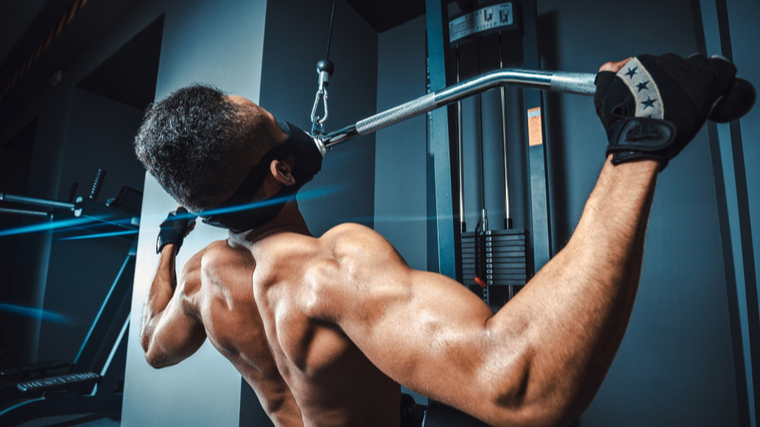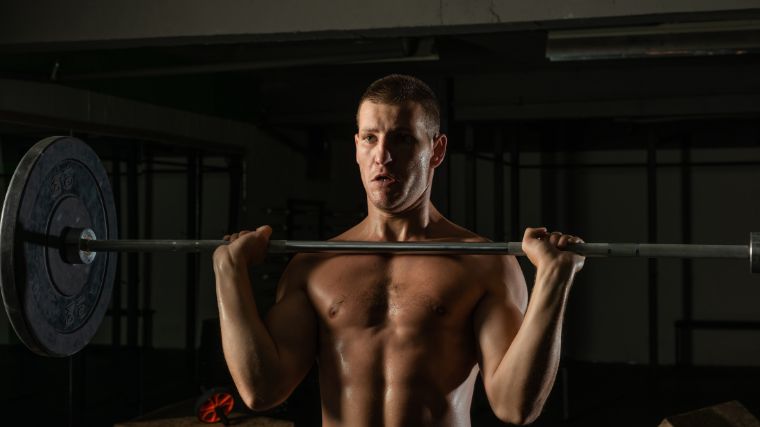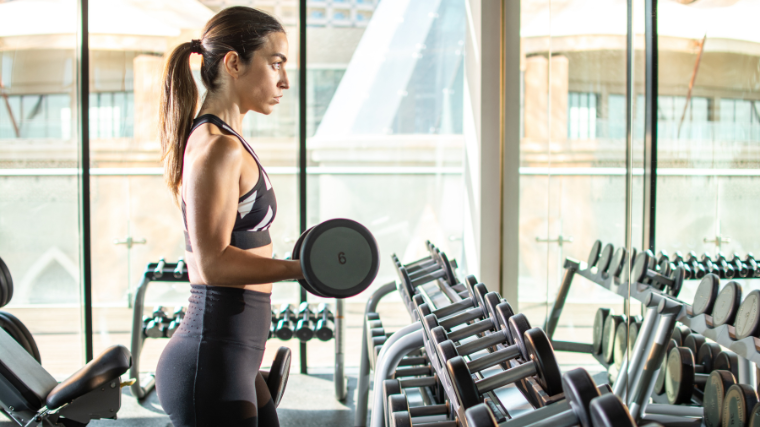You can flex your biceps, spread your lats, or stomp your quads all you want, but as a bodybuilder, your physique isn’t presented in isolation. It’s part of a comprehensive package. You can’t just omit certain muscles from your overall aesthetic, whether you compete on stage or not.
Despite that, the body part split reigns supreme as the de-facto method of bulking up. But what happens when you don’t have five full days to grind away in the weight room, or you’re caught in a bind and have to get a solid workout in over your lunch break?

Full-body training isn’t exactly a bodybuilder’s bread and butter. But in the right contexts, it can be your saving grace, help you build a reliable foundation, or inject some much-needed novelty into your routine. Here’s how to build your body as a unit in one single workout.
Best Full-Body Bodybuilding Workouts
- Beginner Full-Body Bodybuilding Workout
- Intermediate Full-Body Bodybuilding Workout
- Advanced Full-Body Bodybuilding Workout
Full-Body Bodybuilding Workout for Beginners
Full-body workouts are particularly valid (and valuable) for beginners due to their sheer efficiency. When you’re just starting out in the gym, whether as a want-to-be-someday physique competitor or strength athlete, it’s in your interest to paint in broad strokes.
You can make heaps of progress and learn the ins and outs of lifting weights without relying on dozens of different exercises to get the job done.
The Workout
As a beginner interested in muscle growth, your main concern should simply be ensuring you hit every muscle in your body on a weekly basis. This means a lot of compound, multi-joint movements, working in different planes of motion, and with a variety of different tools.
- Deadlift: 3 x 6
- Box Squat: 3 x 8
- Bench Press: 3 x 8
- Barbell Row: 3 x 8
- Chin-Up: 2 x 12-15
How to Progress
No matter how you train, progressive overload is the name of the game as a beginner. There’s no reason to overcomplicate things — early on, your best bet is to look for conservative, consistent increases in weight workout-to-workout, or week-to-week.
Look to add between five and 10 pounds to at least one of your major lifts on a weekly basis.
Full-Body Bodybuilding Workout for Intermediates
A bodybuilding “intermediate” is generally considered to be someone with at least a couple of years of solid training under their belt, who may not be at the competitive stage yet, or who hasn’t reached their individual ceiling for growth.
The gains still flow, though perhaps not as freely as they once did. Intermediates can make progress pretty well with the right training split, but a tight schedule or other lifestyle factors might force you into full-body training for a period of time.
The Workout
If you have several years of training in your rearview already, you probably won’t make “optimal” gains with a full-body routine. However, you can still keep the ball rolling with creative exercise pairings and some high-intensity techniques to induce maximal muscle fatigue.
- Front Squat: 3 x 6-8
- Dumbbell Bench Press superset Seal Row: 3 x 8 + 8
- Dumbbell Walking Lunge superset Renegade Row: 2 x 10 + 10
- (Optional) Leg Extension superset Leg Curl: 2 x 12 + 12
- Dumbbell Flye superset Dumbbell Lateral Raise: 2 x 12 + 12
- (Optional) Cable Crunch superset Calf Raise: 2 x 15 + 15
Note that you should be able to dial up or down your volume on an as-needed basis. Two of the supersets laid out here are optional, since you do work those muscles to a degree elsewhere in the session.
If you have the time or energy to spare, or just want to ensure you’re getting a comprehensive stimulus, perform the routine as-written.
How to Progress
Progressing as an intermediate is more similar to a beginner’s avenue than it is different. You’ll still rely on progressive overload, but it may not be as simplistic as adding another few pounds to your barbell every time you set foot in the gym.
Once that becomes impractical to do regularly, you can advance by adding additional sets, reps, or reducing your rest time between exercises to increase the density of your workload. Look for little bumps in weight where you can find them, but don’t be afraid to get creative.
Full-Body Bodybuilding Workout for Advanced Athletes
To not beat around the bush, advanced physique athletes or bodybuilders working toward their pro cards aren’t the best audiences for full-body training.
Where a novice can paint broadly and make tangible progress, a five or 10-year gym veteran will generally need a much more refined and precise approach.
The Workout
Full-body training can be of limited use to high-level bodybuilders in the event they simply don’t have the time to make it into the weight room multiple days per week.
In such cases, one solid workout of a few solid compound movements pushed to the brink of failure will at least guarantee that you don’t lose any muscle until such time that you can return to more “traditional” training.
- Back Squat: 4 x 6,8,10,12
- Snatch-Grip Romanian Deadlift: 3 x 10-12
- Weighted Pull-Up: 4 x 12, then two unweighted drop sets.
- Bench Press: 4 x 6,8,10,12
- Barbell Cheat Curl superset JM Press: 3 x 12-15 + 12-15
- Cable Crunch + Dumbbell Lateral Raise + Calf Raise: 2-3 x 15 + 15 + 15
How to Progress
Put simply, this workout isn’t really something for you to utilize as a long-term progression pathway. It’s more of a form of training triage to call upon in the event you can’t get after it five or six times per week.
However, you can still make some progress for yourself in the same way any other gymgoer would. Push your numbers where you can, trim down your rest times, and strive for perfect technique from start to finish.
It’s important to note that advanced bodybuilders often view their progress through a unique lens. After enough years in the gym, your rate of muscle hypertrophy will slow down significantly.
As such, you must be willing to pull back and look for changes over the course of several months, instead of week to week. You should also put stock into concepts like proportion and symmetry, your posing routine if you aspire to a physique show, and the like.
Benefits of Full-Body Bodybuilding Workouts
It may fly in the face of conventional bodybuilding wisdom, where the body part split reigns supreme and little else compares, but training your body as a unit is far from a waste of time.
In fact, this style of lifting comes with its own assortment of specific benefits you can’t get from your run-of-the-mill back-and-biceps workout.
They’re Great for Beginners
First-time gymgoers looking to add muscle are prime candidates for full-body training. This style of lifting helps you develop a broad and stable baseline of fitness.
It teaches you how to brace, exposes you to a variety of different movements in the same session, and builds physical resilience that you can transfer over to bodybuilding, powerlifting, or any other avenue in due time.

Beginners can certainly do well with small, isolated training in their first months, but that’s more due to the fact that just about anything “works” in the beginning as long as you train hard.
They Save a Lot of Time
Perhaps the strongest case in favor of full-body training is its efficiency. This is doubly true if you can make your workout work without having to traverse a busy gym or utilize several different types of equipment.
Full-body workouts can be deceptively brief, despite the fact that they’re meant to tax you from head to toe. A reliance on high-value compound movements gives you a lot of bang for your buck — you should be able to get in and out of the gym in an hour or less, most of the time.
Will Teach Movement Congruity
It may not matter as much to a bodybuilder as it does a powerlifter or weightlifter, but technical proficiency should still be of concern to some degree.
If you’re not comfortable working with free weights, you’re not likely to get a strong muscular contraction or know how to safely push your limits in the gym.
Full-body training gains some points here. The reliance on compound lifting will teach you how to hinge, press, pull, squat, and more. And it’ll teach you quickly.
Drawbacks of Full-Body Bodybuilding Workouts
Make no mistake, full-body training probably isn’t the golden grail of bodybuilding. For those who aspire to muscle mass above all else, it isn’t the most optimal avenue, despite being useful in a pinch.
They Lack Specialized Attention
The biggest and most obvious drawback to a full-body workout is that it lacks the detailed stimulation a body part split can provide. Intermediate, advanced, and professional bodybuilders are constantly working to refine their physiques and address weaknesses.
This is usually done by including certain specific movements that work the lagging muscles in isolation, which isn’t logistically feasible on a full-body training plan.
You can stimulate everything to a certain degree, but you won’t be able to zone in on one specific aspect of your physique on a full-body routine.
They May Not Contain Enough Volume
Hand-in-hand with a lack of precision comes a lower overall training volume. Your volume in the gym will be the primary driver of growth and adaptation over time, but for bodybuilders, such things are muscle-specific.
You may not be able to accrue enough productive volume to grow your biceps if you’re only doing three or four sets of pull-ups or rows during your workout.

And, if you did adjust your training to hit that kind of benchmark, it might bring with it too much systemic fatigue from an inordinate amount of high-intensity compound lifts.
You Might Have Trouble Gaining Strength
Bodybuilders aren’t judged on how strong they are, but you shouldn’t fully forsake getting stronger in your pursuit of muscle gains. Stronger muscles help you lift more weight, which applies more mechanical tension, and thus can help you grow faster.
However, you might find it difficult to build up your strength on certain exercises in a full-body workout. After you’ve already worked three or four heavy compound lifts, you may be too tired to push your intensity enough.
That doesn’t mean it’s impossible to get stronger on a full-body routine focused on muscle growth, but it may be an uphill battle.
Muscle From Head to Toe
Your physique should be a full package — no muscle left behind, no pose underwhelming. But developing your physique from top to bottom doesn’t necessarily mean you need to train all those muscles all at once.
Body part splits definitely get the job done, and are the weapon of choice for most physique pros. However, that doesn’t mean full-body training has no place in your arsenal.
Whether you’re a beginner or are pressed for time but still want to forge an impressive physique, the right full-body workout plan can set (or ensure you stay) on the right path for gains for as long as you lift.
Featured Image: OPOLJA / Shutterstock